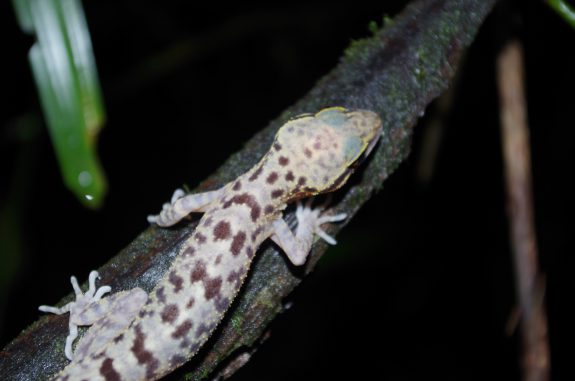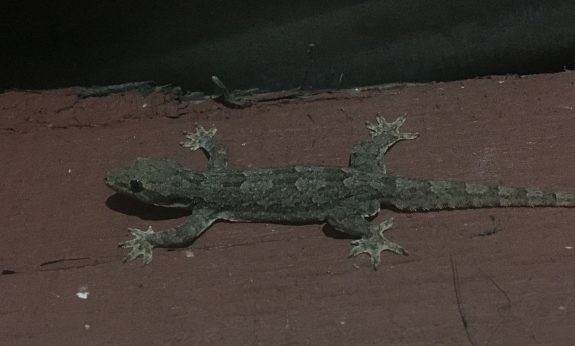Last year I spent 3 months carrying out nocturnal amphibian encounter surveys at varying elevations on Mount Kinabalu in Sabah, Malaysia. When the weather was suitable these surveys were carried out along a number of transects which represented a multitude of habitats on the mountain. Some of these were trails along rivers and others through varying densities of rainforest. One thing that I quickly learned is that due to the vast abundance of wildlife present at Mount Kinabalu National Park, I encountered much more than amphibians on these transects. The one group of animals that always brought a smile to my face when encountered were geckos and I’m going to share my experiences of them with you. This wasn’t the first time I’d been to Malaysian Borneo; I’d also visited in 2015 to carry out similar research but unfortunately this fell through when my visa was denied.
Bent-toes

The mountain itself is abundant in gecko species but the most spectacular is the Kinabalu bent-toed gecko (Cyrtodactylus baluensis) which is endemic to northern Borneo. These were often seen on our nocturnal amphibian surveys, hunting for invertebrates or just resting on low-level vegetation. The first individual of this species I saw wasn’t on the mountain itself but just outside our lodgings roughly 500 metres away from the park entrance. I was with a colleague checking a pond for amphibians when I first noticed the gecko. It then became the centre of our attention as we instantly knew we hadn’t seen one before. Once our surveys on the mountain became far more regular we realised that C. baluensis is super abundant at elevations between 1600-2000 metres above sea level. The species has a snout to vent length (SVL) of up to 85 millimetres so it’s a relatively large species. The geckos are also nocturnal and arboreal, meaning we encountered them quite regularly on the amphibian transects.
House Geckos in the House
Mount Kinabalu wasn’t the only area where geckos were abundant. Our lodgings were also teeming with a number of gecko species, of all sizes. One of the most memorable is the common dwarf gecko (Hemiphyllodactylus typus) due to its diminutive size. Again the species is arboreal and interestingly every individual of the species is female: they reproduce by parthenogenesis or ‘virgin birth’. The reason I can remember encountering this species so vividly is due to the somewhat unusual nature of the event. My colleague and I had come back from the mountain after a day of setting up transects in the rain and marking their locations with a handheld GPS device. He’d gone off to order us dinner at the local restaurant and I went back to the cabin to put our equipment away. Just before I left to join my colleague, I went to use the bathroom. To my astonishment a tiny gecko was stuck in the sink. I scooped it out and released it after taking some photos (one of which is shown below). I then re-joined my colleague and we spent all evening trying to find out which species this baby gecko could be. Finally we discovered that it was fully grown and it was in fact Hemiphyllodactylus typus.

Being amphibian specialists, the gecko species of the area were a real challenge to identify and I’d sometimes send photos via Twitter for my friends and colleagues to see if they could help. Unfortunately we never encountered the gecko species we admire most, the Tokay gecko (Gekko gecko). One of the major issues we were having with identification is that the species we were encountering are all highly variable. The field guides we had access to only show one or two of the most common forms and not the specific colourations for the area where we were staying. As I’m sure you’re aware, some species are closely allied to human habitation. This occurs for a number of reasons but the most commonly understood is that geckos use artificial lighting as an opportunity to hunt insects that are attracted to them. We observed this multiple times whilst eating dinner; the lights illuminating the restaurant attracted a whole array of moths, beetles and other insects. The geckos were fast and often skittish but they were definitely keeping the insect numbers down. The most common of these was the flat-tailed house gecko (Hemidactylus platyurus) which has a SVL of 69 millimetres.

Other gecko species that were commonly encountered on both amphibian surveys and around our accommodation were the Asian house gecko (Hemidactylus frenatus) and the four-toed house gecko (Gehyra mutilata). The species are medium sized geckos that are nocturnal and feed on insects.


Fantastic! Thank you for sharing your adventures.